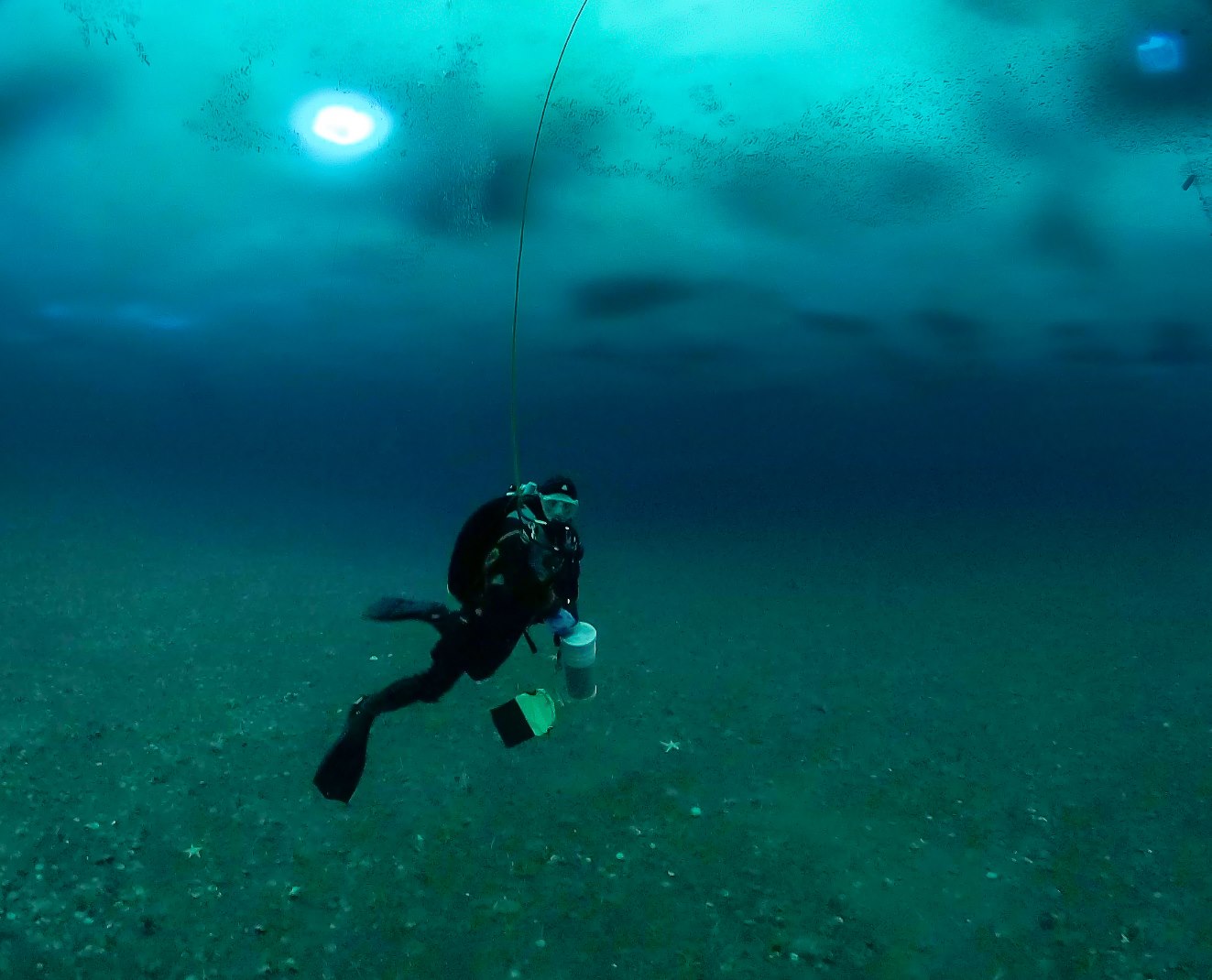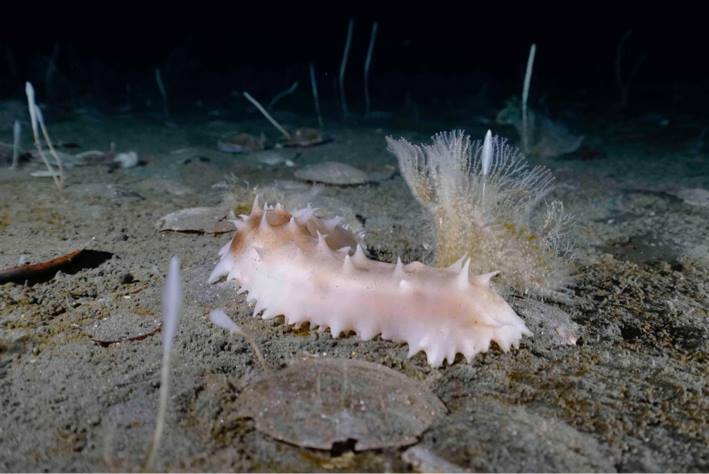Diving Scientists Report 'Big Changes' Beneath Antarctic Ice Shelf

Climate change may be leading to shifts in the communities of sea life beneath an Antarctic ice shelf, researchers say.
Scientists diving beneath sea ice at the edge of Antarctica's Ross Ice Shelf have discovered unexpected changes in the seafloor ecosystem compared to previous studies of the same area, and they think the thinning of the ice shelf caused by climate change may be to blame.
"Surprisingly big changes in the coastal seafloor communities have occurred in only a few years," Patrick Degerman, one of three researchers from Finland on the expedition along with six from New Zealand, wrote in a dispatch from the team's camp on the ice shelf near New Harbour in the Ross Sea.
"Two days ago, [two of the researchers] did the first dive of the year under the ice in crystal clear water, and much to everyone's surprise, the animal community on the seafloor had changed dramatically since the last visit in 2009," he wrote in the first week of November on the expedition's Facebook page, "Science Under the Ice." [See Photos of the Big Changes Beneath the Antarctic Ice Shelf]
For the duration of the six-week expedition, the team members from Finland are regularly updating the page with posts, photographs and videos of their work above and below the ice.
"The first diver observations show that the changes can be unexpectedly rapid, even in Antarctica, where everything is expected to happen very slowly due to the low temperature," Degerman wrote.
The seafloor beneath Antarctica's ice shelves is usually in complete darkness and lacks most of the "marine snow" of phytoplankton and other biological material that rains down from the sunlit levels of other parts of the ocean.
Get the world’s most fascinating discoveries delivered straight to your inbox.
Although the depth of the dive sites beneath the ice shelf is only about 66 feet (20 meters), the sparse animal life found there is similar to that found in the very deepest parts of the oceans, and consists mainly of organisms like deep-sea sponges, sea stars, brittle stars and sea cucumbers.
"What used to be a very stable, sparse and food-deprived animal community on the seafloor under the thick ice in New Harbour is now much richer, with more species and higher densities of animals," Degerman wrote. "Some species rarely observed at this site now appear to be relatively common."
Changing climate
The researchers are spending six weeks at two camp sites on the Ross Ice Shelf, the largest and southernmost ice shelf on the Antarctic continent. Both sites have been studied by previous diving expeditions, so the researchers can make a scientific comparison of any changes that have occurred over time.
"The aim of this expedition is to explore how climate change will affect the marine biodiversity in Antarctica," Degerman wrote. "Almost all of the biodiversity in Antarctica is found in the oceans. A unique combination of species and isolation has provided a place to treasure, largely unaffected by human activity."
The researchers think the changes in the seafloor ecosystem seen at the New Harbour site are probably the result of thinning sea ice that permits more light to filter through, and occasionally breaks up in the Antarctic summer months.
"New Harbour sea ice can go for years without breaking [up], and this multiyear ice can grow up to 4.5 meters [15 feet] thick. When the ice is thick, very little light can penetrate the ice to fuel primary production (for example, algae), and thus food supply to the animals on the seafloor is limited," Degerman wrote.
"The rich community now observed is most likely a rapid response to the sea ice breaking out two years in a row, resulting in more light and higher productivity in the ecosystem," he added. "The ice is currently about 3 meters [10 feet] thick."
In addition to conducting scientific research, the Finnish researchers are also recording the work of the expedition using five 360-degree video cameras. It's the first time an entire scientific expedition has been documented in virtual reality.
The 360-degree video will be available early next year after being processed in Finland, but until then, the researchers are regularly sharing photographs and videos of their work above and below the ice shelf, including aerial drone footage and underwater video from the dive site at New Harbour, some of which was posted to YouTube on Nov. 8.
Moving on
During the last stage of their stay at the New Harbour camp and dive sites, the researchers conducted "closed chamber" experiments on the seafloor to examine how much food is consumed by animal species that are common in the ecosystem, such as brittle stars (Ophionotus victoriae). [Weird Wildlife: The Real Animals of Antarctica]
The closed-chamber experiments would "analyse the food webs (who eats who) to compare with previous analyses conducted in 2001, 2002 and 2009, when sea ice conditions were very different, to reveal how food webs have changed over the last 15 years and what this will imply for the future of these unique ecosystems," Degerman posted to the expedition Facebook page early last week.
"The aim is to investigate how the seafloor ecosystem will work differently as a result of climate change," University of Helsinki marine biologist Joanna Norkko wrote in a Nov. 6 update.
"In addition to warmer temperatures, climate change is expected to lead to increased food availability to the animals on the seafloor. This is because the sea ice is predicted to get thinner, which means that more light will penetrate the ice, which, in turn, means that there will be more algae growing on the underside of the ice (so-called ice algae)," Norkko explained. "These algae are the main food source for many of the animals on the seafloor."
In their most recent posts from the ice, the researchers reported that they've now struck their camp at New Harbour and have returned briefly to the New Zealand Antarctic headquarters at Scott Base. Next, they will head to their second camp on the Ross Ice Shelf, near Cape Evans on Ross Island.
"[We] spent two days packing up the whole camp to go back to Scott Base for a day to repack (and have a shower) before heading out to our second site at Cape Evans for a few days of diving," reads the latest update, posted Tuesday (Nov. 14).
"But, as is quite common in Antarctica, the weather had its own way, and snow and increasing wind forced us to wait until the late evening before we could start driving back to Scott Base in the two Hägglunds [tracked snow vehicles], towing all of our gear on big sleds," they wrote in the update. "It was a beautiful night though! Thanks to the Scott Base staff for driving all through the night!"
Editor's Note: This article was updated to clarify that the scientists were diving beneath sea ice at the edge of the Ross Ice Shelf, not beneath the shelf itself.
Original article on Live Science.
Tom Metcalfe is a freelance journalist and regular Live Science contributor who is based in London in the United Kingdom. Tom writes mainly about science, space, archaeology, the Earth and the oceans. He has also written for the BBC, NBC News, National Geographic, Scientific American, Air & Space, and many others.





